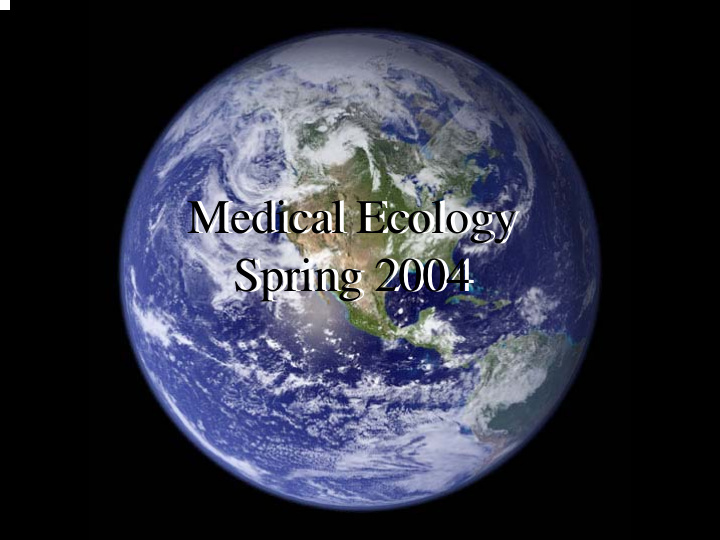



Medical Ecology Medical Ecology Spring 2004 Spring 2004
Infectious Diseases The Atmosphere Water Food
Atmosphere Atmosphere
Typical Plant Cell
Atmosphere = 20% oxygen
Evolution of Terrestrial Ecosystems Begins Evolution of Terrestrial Ecosystems Begins
Each has a genome Chloroplast Mitochondrion Lynn Margoulis The Gaia Hypothesis James Lovelock
Thermostat
One Example Of How Gaia Hypothesis Works: Cloud Formation
Coccolithic Phytoplankton
http://www.soes.soton.ac.uk/staff/tt/
Layers Of The Atmosphere
http://www.NCSEonline.org/NLE/CRSreports/Stratospheric/strat-5.cfm?&CFID=12207930&CFTOKEN=7083239
Montreal Protocol The Montreal Protocol on Substances that Deplete the Ozone Layer was adopted in 1987 as an international treaty to eliminate the production and consumption of ozone-depleting chemicals, with developing countries benefiting from a ten-year grace period.
Periodic Table Of The Elements
Methyl Bromide Alternatives Project MAP to a Healthy Harvest Methyl brom ide alternatives projects
Global Atmospheric Circulation
http://www.cmdl.noaa.gov/ozwv/ozsondes/spo/ozppp2001.html
These maps show the mean 1978-1988 level estimated using Total Ozone Mapping Spectrometer (TOMS)data for all areas except the Antarctic and from the pre-1980 level estimated using Dobson data over the Antarctic.
Ozone Hole over Antarctica http://www.sdsc.edu/tmf/Examples/Ozone/ozone.html
Ozone Hole Monitoring
Reference archives 1.Envirolink Click on the Ozone folder. Note in particular the FAQ's by rparson(Robert Parson, Univ.of Colorado), they are by far the best tutorials on Ozone depletion on the entire net! 2.NOAA has written up several research summaries on History and overview of Ozone shield, Stratospheric Ozone and Tropospheric Ozone ; all written at a laymans level. 3. Earthwatch Radioscripts on Ozone :Earthwatch ph# is (608)263-3063, and I have found them to be quite helpful in giving further information and contacts used in their broadcasts. 4. NSF index this is the National Science Foundation's search index; type in 'ozone' and hit the enter key. 5. Galaxy directory service for EINET Contains a wide assortment of articles on different aspects of the depletion problem and the remedies for it; not necessarily the best place to start if you are just starting to learn about the problem. 7. Ozone lesson-plans from the University of Kansas Nice summaries of lesson plans which teach about the Ozone problem. You can download details of these lessons if you have Claris works. 9. CIESIN (Consortium for International Earth Science Information Networks) homepage this file has a nice summary of many the various protocals and international meetings that have been conducted in order to combat ozone depletion.
http://sedac.ciesin.org/ozone/docs/uvd-home.html
Recommend
More recommend